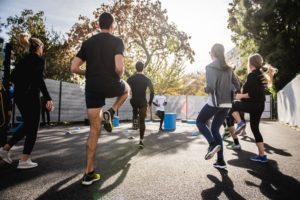Use It or Lose It- How to Start Exercising
If you’ve been following my previous posts, you are now sleeping better and eating better. You did all the actions I suggested about sleep and diet, right? Well done! I knew you could! But there’s another item on the list to discuss in more detail – exercise.
We all know we should exercise, but, for most of us, getting ourselves to do it is not easy. As I’ve discussed previously, our bodies are designed to conserve energy, which helps us survive in times of scarcity. In the U.S., however, scarcity is rarely a problem. But the evolutionary urge to be a couch potato still persists. So how do we overcome this?
Why Exercise Matters
First, let’s talk about why we should exercise. We all know it’s good for us, but why is that?
It’s evolution at work. We evolved as hunter/gatherers, which are complex tasks requiring significant mental and physical capacity. The more you simulate hunting/gathering (ie. exercise), the more you build both muscle and brain power to help you maintain these tasks. When you aren’t active, your brain and muscles atrophy, because your body doesn’t want to continue to supply precious calories to unused organs. It’s a “use it or lose it” scenario.

Photo by Gabin Vallet on Unsplash
So, exercise makes you both stronger and smarter. Plus, your heart, lungs, and blood flow all improve, because these need to be stronger for adequate exercise as well. In fact, exercise tends to benefit nearly every organ in your body, and significantly decreases the chances of a multitude of diseases, including a lower risk of cancer and dementia. And, even more importantly, you’ll likely have more energy, look better, feel better, and improve your mood. Who doesn’t want that?
What’s The Best Exercise?
Now back to the “how”. I’m often asked, “Doc, what’s the best exercise?” My answer is, “The best exercise is the one that you’ll do.” If your friend says you should swim for exercise, but you hate swimming, then it’s not a good option. Choose the activity that you like most (or least dislike). Anything that gets you off the couch counts. If your favorite activity is badminton, play badminton. Walking may not feel like “exercise”, but it absolutely counts. Movement is the key.
Once you’ve chosen an activity, now you must get yourself to do it. The first step here is to set the bar low. Again, any movement counts. A ten-minute walk is still better than nothing. If you resolve to go to the CrossFit gym for two hours every day and don’t do it, all you get is frustration. But if you say, “I can walk for ten minutes at lunch”, and it happens, you feel a sense of accomplishment, because you reached your goal. It’s much better to set a low goal and succeed than to set a lofty goal and fail.
Another great motivator is to have an objective. Sign up for a fun run, bike race, or activity such as soccer or basketball. When you know there is a deadline or others counting on you for which you need to be prepared, you’re much more likely to be motivated. Also, these activities are usually social, which makes exercise more fun, which in turn makes you more likely to do it.
Once you start, you need to keep up the momentum. Create exercise prompts for yourself. Add a daily reminder to your smartphone, place a sticky note on your computer, or tell your co-worker to remind you to get out during lunch (and have them come with you).
And stay positive! If you think exercise improves your mood, your energy, and your body image (which it does), it’s much easier to start.
Time to “Get Your Sweat On”
Finally, two more quick points. The word “exercise” has a lot of bad connotations for some people. If you equate exercise with shame, frustration, and failure, then stop calling it “exercise”. Instead call it “physical activity”, “movement”, or “gettin’ your sweat on”. Also, if you’re like me and just can’t exercise inside, remember my favorite saying – “There’s no such thing as bad weather, just bad gear.” When it was 20 degrees in January, I still rode my bike to work…with the proper gear, of course.
So, your homework items are as follows:
- Choose an exercise you enjoy, or are most likely to do
- Set the bar low – any movement is better than none
- Create goals/objectives
- Remove barriers to exercise, such as negative thinking or “bad” weather
Follow Nike’s advice – “Just do it”, whatever “it” may be. Good luck, good health, and stay safe!
Ken Zweig, M.D.
Northern Virginia Family Practice Associates

